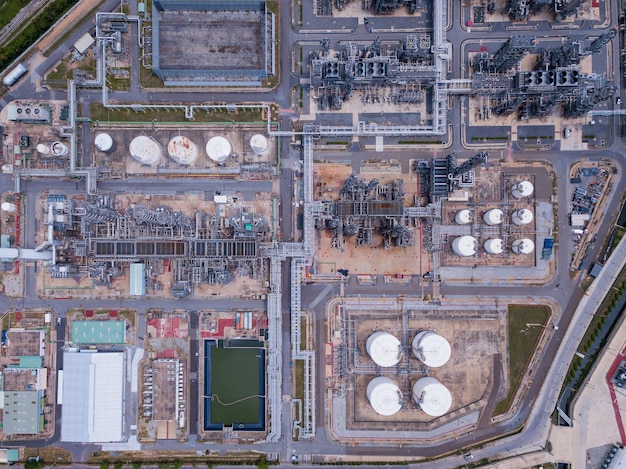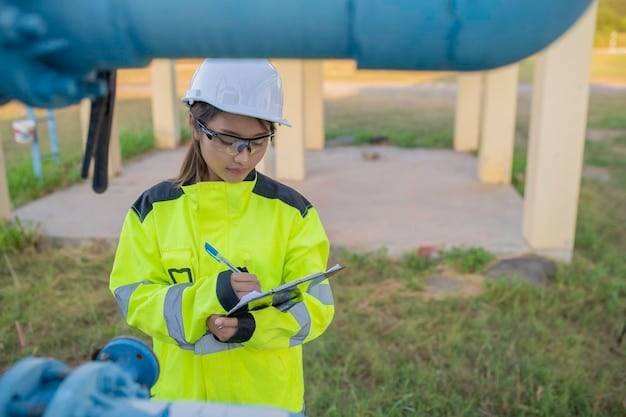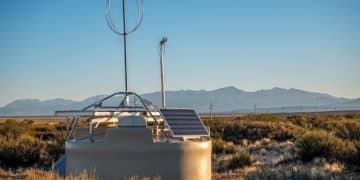EPA Methane Rule: Impact on US Energy Companies & Compliance

New EPA Regulations mandate a 15% reduction in methane emissions from US energy companies, impacting their operations, compliance strategies, and investments in leak detection technologies to mitigate climate change.
The Environmental Protection Agency (EPA) has introduced stringent new EPA Regulations aimed at curbing methane emissions from the US energy sector. This new rule, targeting a 15% reduction in methane emissions, has significant implications for energy companies operating in the United States, affecting their operational strategies and financial investments.
Understanding the New EPA Methane Regulations
The recent EPA regulations represent a major step toward addressing climate change by targeting methane, a potent greenhouse gas. These regulations are designed to reduce methane emissions from various sources within the oil and natural gas industry, compelling companies to adopt stricter monitoring and mitigation practices.
Key Provisions of the Methane Rule
The EPA’s methane rule is comprehensive and covers numerous aspects of oil and natural gas operations. Some of the key provisions include:
- Establishing new standards for equipment leaks and fugitive emissions;
- Requiring regular monitoring and reporting of methane emissions;
- Setting guidelines for pneumatic controllers and storage vessels;
- Implementing best practices for well completions and workovers.
These provisions aim to create a framework that promotes the use of advanced technologies and sustainable practices to minimize methane leaks and emissions across the entire oil and natural gas supply chain. The regulations are expected to incentivize the development and deployment of innovative methane detection and mitigation solutions.

The introduction of these new EPA Regulations reflects the agency’s commitment to addressing climate change through targeted and effective measures. By setting clear standards and requiring accountability, the EPA intends to foster a culture of environmental stewardship within the energy industry.
Impact on US Energy Companies
The new EPA Regulations will have a wide-ranging impact on US energy companies, influencing their operational practices and investment decisions. These companies must now reassess their current infrastructure and implement strategies to comply with the stricter emission standards.
Operational Adjustments
Energy companies will need to make significant operational adjustments, including:
- Upgrading equipment to reduce methane leaks;
- Implementing more frequent and thorough leak detection surveys;
- Improving monitoring and reporting systems;
- Enhancing training programs for employees to identify and address methane emissions.
These adjustments will require a significant investment in new technologies and infrastructure, as well as a shift in operational culture toward proactive environmental management. Companies that fail to comply with the new regulations may face substantial penalties and reputational damage.
Moreover, the new EPA Regulations may lead to increased operating costs for energy companies, as they must invest in the necessary resources to meet the stricter standards. However, these investments can also yield long-term benefits, such as improved efficiency and reduced waste.
Compliance Strategies and Technologies
To comply with the new EPA Regulations, US energy companies will need to adopt effective compliance strategies and invest in advanced technologies. These strategies and technologies will play a crucial role in reducing methane emissions and ensuring regulatory compliance.
Leak Detection Technologies
One of the key areas of focus will be leak detection. Energy companies will need to deploy advanced technologies to identify and repair methane leaks quickly and efficiently. Some of the most promising leak detection technologies include:
- Aerial surveys using drones and aircraft equipped with methane sensors;
- Ground-based mobile leak detection units;
- Satellite-based monitoring systems;
- Continuous monitoring sensors installed at well sites and processing facilities.
These technologies can help companies detect even small leaks, allowing them to take prompt corrective action and minimize methane emissions. The use of advanced leak detection technologies will not only ensure compliance with the EPA regulations but also improve operational efficiency and safety.

In addition to leak detection, energy companies will also need to implement best practices for leak repair and mitigation. This includes developing comprehensive maintenance programs, training employees to identify and address leaks, and using advanced repair technologies to fix leaks quickly and effectively.
Economic Implications of the New Regulations
The new EPA Regulations will have significant economic implications for US energy companies, affecting their investment decisions and financial performance. These economic impacts must be carefully considered to ensure a smooth and sustainable transition to a lower-methane energy system.
Investment in Methane Mitigation
Energy companies will need to make substantial investments in methane mitigation technologies and practices to comply with the new regulations. This includes investments in:
- Upgrading equipment;
- Implementing leak detection and repair programs;
- Developing monitoring and reporting systems;
- Training employees;
These investments may lead to increased capital expenditures and operating costs for energy companies. However, they can also create new economic opportunities, such as the development and deployment of innovative methane mitigation technologies.
Moreover, the new EPA Regulations may incentivize the development of new business models and partnerships that focus on reducing methane emissions. This could include collaborations between energy companies, technology providers, and environmental organizations.
Environmental Benefits of Methane Reduction
Reducing methane emissions offers significant environmental benefits, particularly in mitigating climate change. Methane is a potent greenhouse gas, and its reduction can have a near-term impact on global warming.
Climate Change Mitigation
Methane is a short-lived climate pollutant, meaning that it has a relatively short lifespan in the atmosphere compared to carbon dioxide. However, it has a much higher global warming potential, making it a significant contributor to climate change. Reducing methane emissions can therefore have a rapid and noticeable impact on global warming.
- Slowing the rate of global temperature increase;
- Reducing the frequency and intensity of extreme weather events;
- Protecting sensitive ecosystems from the impacts of climate change;
- Improving air quality and public health.
By targeting methane emissions from the energy sector, the new EPA Regulations can help to achieve significant climate benefits in the near term. This is particularly important as the world strives to meet the goals of the Paris Agreement and limit global warming to 1.5 degrees Celsius.
Future of Methane Regulations in the US
The new EPA Regulations are likely to be just the beginning of a broader effort to address methane emissions in the US. As climate change concerns continue to grow, it is expected that further regulations and policies will be implemented to reduce methane emissions from various sectors, including agriculture and waste management.
Potential for Expansion
The EPA may expand its methane regulations to cover additional sources and activities, such as:
- Abandoned oil and gas wells;
- Agricultural operations;
- Landfills;
Moreover, the agency may strengthen existing regulations, such as by increasing the stringency of emission standards and expanding monitoring requirements.
The future of methane regulations in the US will depend on a variety of factors, including technological advancements, economic considerations, and political priorities. However, it is clear that methane emissions will continue to be a key focus of environmental policy in the years to come.
| Key Topic | Brief Description |
|---|---|
| 🌱 Regulation Aim | Targets a 15% cut in methane output from US energy firms. |
| 💰 Economic Impact | Requires investment in new tech; could boost efficiency and innovation. |
| 🌎 Environmental Benefit | Helps significantly in curbing climate change near-term. |
| 🔬 Tech Needs | Advanced leak detection systems are critical for compliance. |
[Frequently Asked Questions]
▼
The main goal is to reduce methane emissions from the US energy sector by 15%, thereby mitigating climate change and improving air quality.
▼
The regulations primarily impact US energy companies involved in oil and natural gas operations, requiring them to adhere to stricter emission standards.
▼
Advanced leak detection technologies, such as aerial surveys and continuous monitoring sensors, are critical for identifying and addressing methane leaks effectively.
▼
Companies may face increased capital and operating costs due to investments in new equipment and compliance measures, but can also see long-term efficiency gains.
▼
Reducing methane emissions can significantly slow the rate of global warming, improve air quality, and protect ecosystems from the impacts of climate change.
Conclusion
The new EPA Regulations represent a crucial step towards reducing methane emissions from the US energy sector. By setting clear standards and incentivizing the adoption of advanced technologies, these regulations aim to create a more sustainable and environmentally responsible energy industry. While compliance will require significant investments and operational adjustments, the long-term benefits for the environment and public health are undeniable. As the world continues to grapple with the challenges of climate change, these regulations serve as a model for effective and targeted action in the energy sector.





